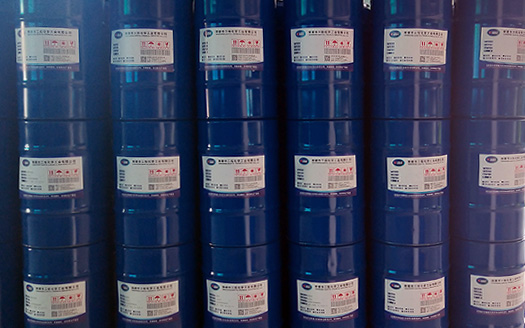Interpretation of the application of dispersants in coatings
Article Source: Santol Chemical Reading: Issuing time:2019-08-09
First, the role of dispersants in coatings
The pigments used in coatings are mostly in the form of agglomerates and agglomerates of primary particles. If these pigment particles of different sizes cannot be dispersed into smaller particles or primary particles, and they will no longer be Aggregation or flocculation of a stable dispersion system will cause defects such as flocculation, coarsening, sedimentation, floating and blooming, decreased gloss, decreased tinting power and hiding power.
The pigments used in coatings are mostly in the form of agglomerates and agglomerates of primary particles. If these pigment particles of different sizes cannot be dispersed into smaller particles or primary particles, and they will no longer be Aggregation or flocculation of a stable dispersion system will cause defects such as flocculation, coarsening, sedimentation, floating and blooming, decreased gloss, decreased tinting power and hiding power.
Second,classification of dispersants
The pigment dispersion process is more complicated, but there are three main effects, namely wetting, deaggregation and stabilization. Only when the three functions of wetting, deaggregation and stabilization can work together can the pigment be uniform and stable. Dispersed in the paint.The use of a suitable wetting and dispersing agent can simultaneously provide pigment wetting, de-aggregation and stabilization, which can not only shorten the grinding and dispersion time, reduce the viscosity of the grinding system, improve the tinting power and hiding power of the pigment, but also prevent the pigment from Flocculation, coarsening and sedimentation, improve the storage stability of the coating, ensure that the pigment is always in a good dispersed state, and maintain the color uniformity.Most pigment dispersants have both a wetting function and a dispersion stabilizing effect.
The chemical structures of commonly used dispersants are:
①Low-molecular-weight carboxylic acid amide salt and electrically neutral long-chain carboxylic polyamino salt, which have more adsorption groups, can form a strong adsorption layer on the surface of the pigment, improve the stability of pigment dispersion, and prevent floating color. Flower effect ②High-molecular-weight carboxylic acid ester polymers form steric hindrance control by adsorbing groups with high molecular chains on the pigment surface, preventing pigment flocculation and maintaining the stability of pigment dispersion systems
③High molecular polymers or block copolymers containing anchor groups, anchor groups can be firmly fixed on the surface of pigments, and higher molecular weight solvated chains can be effectively dispersed in paints, increasing the thickness of the adsorption layer Dispersion stability
④Polyvalent carboxylic acid polymer, which contains more carboxyl groups, has a very strong polarity, which can make the coating form a thixotropic fluid and make the pigment into a controlled flocculation dispersion state, which is very effective in preventing floating and blooming.
Third,mechanism of dispersant
The surface of inorganic pigments has higher polarity, so low molecular weight pigment dispersants are easier to adsorb and can be adsorbed on the pigment surface for a longer period of time; while organic pigment surfaces are basically non-polar, so low molecular weight pigment dispersants are difficult to sustain Ground adsorption requires the use of higher molecular weight dispersants or polymer dispersants containing anchor groups.The adsorption of high molecular weight dispersant on the surface of pigment is adsorbed on the surface of pigment particles through functional groups and polymer anchor chains.At the same time, adsorption morphology is related to the characteristics, morphology, and charge distribution of the pigment surface, the structure, composition, and properties of the polymer compound, the type of solvent in the dispersion medium, and the solubility to the polymer.Macromolecular dispersants are compounds specially designed according to the dispersing purpose required by pigment properties.
Macromolecular dispersants are compounds specially designed according to the dispersing purpose required by pigment properties.Generally speaking, homopolymer is not a good dispersant, because it is a better solvated chain or a better anchoring group, and a good repulsion stabilizing effect needs to have both. It is a copolymer, such as a polymer used as an aqueous system pigment dispersant, which is usually a random copolymer, a graft copolymer, or a block copolymer having both.
Nanxiong Santuo Chemical Industry Co., Ltd. focuses on the development of water-based wetting agents, water-based defoamers, water-based dispersants, water-based tackifiers, emulsifiers, catalysts, hydrophilic treatment agents, adhesion enhancers, and silane coupling agents , Production and sales for 10 years, has its own chemical brand-"EASYTECH EASYTECH" series of high-quality products, Acting Evonik, Teco, Air Chemicals, Solvay, Rhodia, Momentive, Huntsman and other internationally renowned chemical companies Products are widely used in adhesives, coatings, inks, leather, plastics and many water-based systems, and strive to provide customers with the best product solutions.
- What are the reasons for the market acceptance of modified functional resins
- What are the characteristics of modified functional resin
- Zaozhuang feed additive manufacturers wholesale
- What is the difference between matting agents and matting agents
- What are the properties of low melting glass powder used in vacuum glass
- Water-based sand flour product features
- A-9908 special functional resin
- Performance and application of micronized wax
- Interpretation of the application of dispersants in coatings
- Feeling Micro Wax Powder Teflon Feeling Wax Powder


